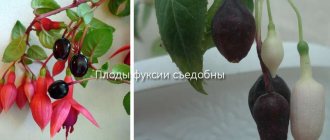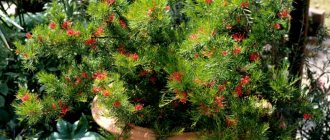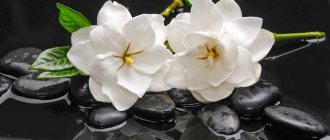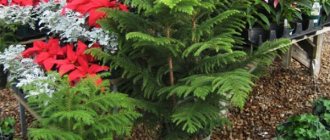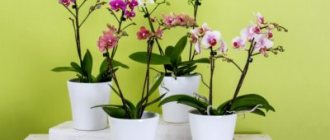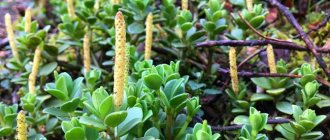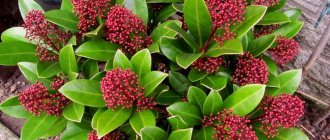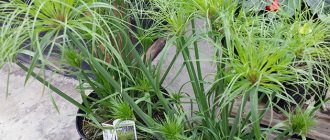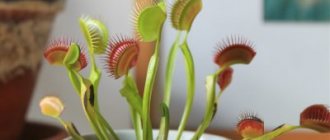What it looks like, what family it belongs to
Peperomia watermelon belongs to the Pepper family. This is a perennial evergreen crop. Flowers come in a variety of varieties, so everyone can choose the perfect variety for themselves.
Peperomia foliage looks like a watermelon
A common feature of all varieties is leathery, shiny foliage, but it also differs in color and shape. Some species have small and thin leaves, while others have fleshy and wide plates with curled ends.
Interesting to know! If you lightly rub a peperomia leaf, it will begin to emit an aroma reminiscent of bell pepper.
The variety of watermelon peperomia can be easily identified by its botanical description. No other crop has such remarkable leaves.
Botanical description
This small herbaceous plant belongs to the pepper family Piperaceae, translated as pepper and identical. In nature, watermelon peperonia grows on:
- on soils rich in peat;
- rotting parts of plants;
- tree bark;
- bushes
Its homeland is South America, where it grows as a ground cover plant. Found in India and Southeast Asia.
Watermelon peperomia is also called silver peperomia - Peperomia argyreia. This variety is considered one of the most beautiful representatives of this genus of plants. The most attractive are its striped leaves. Alternating stripes of silver and dark green give it a resemblance to a watermelon, which is why it got its name.
Watermelon peperomia is a low plant with a characteristic leaf color ; it grows no more than 12 cm in height. Its leaves are:
- leathery;
- smooth;
- ovoid;
- fleshy.
For a fairly small plant, they are large, reaching 5-8 cm in length. They grow on thin stems of a reddish hue. The flower mainly blooms in summer. The flowers do not stand out either for their smell or for their special beauty.
Common varieties
Peperomia - types tin, wrinkled, clusifolia, watermelon, variegated
Peperomia is represented by a variety of varieties. The most prominent representatives:
Variegated
The variety is distinguished by beautiful leaves with fancy variegated colors and an unusual shape.
Variegate peperomia
Climbing
The culture grows up to 1.5 meters in height. With age, the leaves of the bush change color from beige to cream. Indoor flowers are undemanding in care and maintenance.
Variety of climbing peperomia
wrinkled
A decorative crop that stands out from the rest with its miniature appearance. Mature bushes do not grow more than 10 cm. It blooms with white buds that emit a unique aroma.
Representative of the wrinkled species
Lillian
A low-growing variety that has an external resemblance to lilies. After flowering, berries form on the plant.
Miniature Lilian is popular among gardeners
Silver
Popular view. It is valued for its beautiful light leaves with dark veins. In general, the plant has more than 30 varieties. Each of them differs in shape, size and cultivation characteristics.
Silvery peperomia is famous for its unusual leaf color.
Benefits and harms
In addition to the aesthetic contribution to the surroundings of the home, peperomia also brings more significant benefits. Indoor flowers are capable of actively absorbing harmful and toxic substances from the atmosphere, which evaporate the finishing materials of the room, all kinds of detergents and even tap water. The same exhaust gases entering the apartment through an open window during ventilation have a far from favorable effect on human life.
In addition, this bush-like flower can prevent infectious diseases, ARVI and colds. Peperomia also helps to cope with many other diseases. It will be useful to have an ornamental plant for people with cancer. In this case, it is recommended to place the flowerpot in the bedroom, not far from the bed.
If we consider the benefits of the flower from a medical point of view more deeply, it is worth noting its beneficial effect on the digestive system and gall bladder. Additionally, the plant promotes the regeneration of the body during the healing of wounds and postoperative sutures.
According to many signs, peperomia brings peace, tranquility and a friendly atmosphere to the house. This is due to the fact that the plant is able to “radiate” positive energy, and as a result, act as a barrier to depression.
The presence of peperomia in offices would also be useful. Considering the shrub’s ability to “absorb negativity,” most work moments will not cause much passion, and the atmosphere in the team will become more friendly and united.
However, it is always worth taking into account the fact of the individuality of each person - what is beneficial for one may have a completely opposite effect on another.
Briefly about the history of appearance
Peperomia magnoliafolia - home care
The homeland of watermelon peperomia is considered to be South and Central America, as well as India. It was there that this unusual flower was first discovered. Most often found in tropical forests, it prefers to grow in shady undergrowth and also on tree trunks. The plant is literally attached to the bark.
Peperomia has the ability to accumulate moisture in its own leaves, which is why it can go without water for a long time.
Diseases and pests
Since the main scourge of all indoor plants (the cause of both their diseases and death) is hypothermia accompanied by waterlogging, the case of watermelon peperomia is no exception. Since it is a culture quite firmly rooted in the existence, if it becomes “sad,” one should simply change the attitude. But not to herself, but to the methods of caring for the “watermelon-leaved” bush.
If the bush has been lost from sight for a long time or care has become completely worthless, it can be (although this happens quite infrequently) eaten:
- scale insects;
- mealybugs;
- spider mite.
Root nematodes, which quickly reproduce in stagnant swampy conditions, can also prepare for a continuous subsoil “torpedo attack.”
To defeat the first category, traditional and long-tested methods are used - repeated ones:
- insectoacaricidal “attacks”;
- etching the soil with antiseptics.
If it is suspected that nematodes live in the soil, it is replaced with a guaranteed healthy one.
If the death of the plant is inevitable, any healthy part of it is urgently rooted.
Features of care
Watermelon peperomia is an unpretentious crop. She does not require special attention. It is for these qualities that flower growers love her.
Temperature
For normal growth and development, the plant needs the right climatic conditions. A certain temperature regime must be maintained in the room, namely:
- in summer – 20-22 ℃;
- in winter – 18-20 ℃.
It is important to monitor the temperature of the substrate. It should not be below +17 ℃. In colder soil, it is difficult for the peperomia root system to remain viable.
Lighting
The culture prefers eastern and western window sills. If the pot is on the south side, then the flower needs darkening.
In winter, on the contrary, the plant lacks light, so it will have to be artificially illuminated.
Note! Daylight should not last less than 8 hours. For this, fluorescent lamps are used.
Watering
Irrigation water should be at room temperature. Abundant watering is carried out during the growing season and flowering; the rest of the time, water is added as usual. The main thing is not to let the soil dry out, this has a bad effect on watermelon peperomia.
Spraying
If the air in the room where the flower pot is located is too dry, spraying is mandatory. Otherwise, the peperomia will begin to dry out. This should be done at least once every three days.
Humidity
Tropical crops require high humidity. If this indicator is low in the house, then you will have to spray the bushes daily. A container of water placed next to the pot will help correct the situation.
Priming
The substrate for peperomia should be loose and rich in nutrients. You can make it yourself from the following components:
- humus;
- garden soil;
- sand;
- peat soil.
All components are taken in equal volume. When choosing a flowerpot, preference is given to deep containers so that the root system feels free.
Feeding
As for fertilizers, they are applied throughout the season, starting in April and continuing until autumn. Two feedings are carried out per month. Ready-made mineral complexes are suitable for this.
In winter, the flower is not fertilized, since it is in a dormant state; nutrients can cause its activity. The plant will not be able to fully recover.
Signs and superstitions
Peperomia watermelon creates aesthetic appeal. Flowers please the eye and lift your spirits. In addition, peperomia helps:
- create a favorable aura in your home;
- remove negative influences and create a positive atmosphere.
All this has a positive effect on the health of residents. For example, it is believed that watermelon peperomia has a beneficial effect on the functioning of the digestive system, the condition of the biliary tract and mammary glands.
Peperomia watermelon - poisonous or not
The bush does not contain any toxins or poisons, making it completely safe even for children and animals. Accidental ingestion of its parts will not cause any symptoms of poisoning.
When and how does it bloom
Each peperomia variety blooms differently. It is sometimes extremely difficult to achieve flowering. Some gardeners wait for years for the inflorescences to appear. In good conditions, inflorescences appear in late spring or early summer.
Peperomia throws out flower stalks in the form of cobs
Types of flowers
During the flowering period, numerous buds appear on the shoot, reaching up to 7 cm in length. They look like a thin bent process.
Additional Information! In the end, in some varieties, fruits are formed in place of the inflorescences, which can be easily separated from the cob.
Flower shapes
The shape of the buds directly depends on the variety. The wrinkled one throws out tendrils, on which white cobs later form. The view pleases with buds throughout the year.
The whorled plant has a long peduncle. Chisel-shaped peperomia are covered with small white-green flowers in summer.
Flowering period
The ovary of inflorescences in indoor plants begins in the spring and lasts all summer. Some representatives are able to bloom throughout the year without going dormant. After this, the plant rests for several years.
Basic content rules
But it’s not enough to just choose a plant. In order to enjoy its beautiful appearance, proper growth and development for a long time, you need to know and follow the basic recommendations for growing it at home.
All types of peperomia are epiphytes, so the soil in which they grow must be loose. A combination of forest soil, peat, sand and humus in proportions of 3: 1: 1: 1 is considered ideal.
Before planting the plant in the ground, it must be disinfected. To do this, the mixture for the flower pot is poured into an even layer on a baking sheet and heated in the oven for 1 hour at a temperature of 100 degrees. Then it is cooled and only then used for its intended purpose.
A drainage layer in the pot is required. Moreover, its height must be at least 6 cm
It is best to purchase a special mixture at specialized plant growing stores.
Particular attention should be paid to watering peperomia. It should be timely, but not too scanty or abundant
The ideal time for watering is considered to be the moment when the top layer of soil dries 1 cm deep. After watering, water should under no circumstances remain in the tray of the pot.
Lighting is another important factor. Despite the fact that peperomia is a tropical plant, not all its species like intense light. Therefore, depending on the specific type of flower, it is necessary to choose the location for its installation.
The air temperature in the warm season is from 22 to 25 degrees above zero, in the winter – from 18 to 22. At the same time, the temperature of the soil itself should never fall below +17 degrees and rise above +19 degrees.
How does watermelon peperomia reproduce?
Peperomia is propagated in several ways. The choice of method directly depends on the capabilities and experience of the grower. It is worth considering each option in detail.
Germination from seeds
Seed propagation begins in early May. Before planting, the seeds are soaked. After an hour, they are laid out on the surface of a moist nutrient substrate and sprinkled with soil.
The container with planting material must be covered with plastic film. This will provide a greenhouse effect. After 50-60 days, the first shoots will appear.
Note! Peperomia can be planted in separate flowerpots only when the third leaf appears on the shoot.
Rooting cuttings
The procedure is carried out in the spring. To do this, do the following:
- cut off the shoot with a sharp knife; it should contain 2-3 independent buds;
- planted in nutrient soil, covered with a plastic bottle;
- place the container with the cuttings in a warm place;
- After the roots have formed, they are planted in a separate pot.
Usually the whole process takes about a month. During this period of time, the root system has time to develop normally. Then the flower is given standard care.
Propagation by cuttings is carried out in the spring
Other options
Some gardeners use the leaves for propagation. They are simply stuck edgewise into the substrate and covered with a plastic cup on top.
Another option is dividing the bush. To do this, the plants are taken out of the pot, divided into several parts, and then planted in separate containers.
Reproduction of peperomia
Peperomia can be propagated in several ways, but the most common are cuttings and the single leaf method. The process should be carried out in the spring-summer period during active growth of the crop.
Using a sheet
It is recommended to use a leaf on which only nascent or pronounced aerial roots are present. The material should not be placed in water. The formation of the root system in this case will occur extremely slowly, in contrast to the processes of decay.
The best option is to treat the cut with crushed activated carbon and leave it in this state for at least eight hours. Afterwards, the leaf should be placed in a loose soil mixture, the composition of which meets the requirements, and then slightly moistened. The container with the future plant must be placed in a well-lit place. With this propagation method, the main stem will appear only after six months.
Cuttings
Cuttings of any type are used as seed material - both apical and intermediate shoots are quite suitable. You can root them in several ways:
- in sphagnum;
- in a moistened substrate;
- in water.
The effectiveness of how peperomia will reproduce is determined by the presence of nodes in the shoots. However, it is worth giving preference to those branches that have at least three of them.
Important: it is recommended to place the cuttings in partial shade for several weeks, and only then move them to a permanent place of residence with the recommended lighting parameters.
Transfer
The first peperomia transplant is carried out at the 3rd year. Young bushes do not need this procedure. An adult plant is transplanted into a new flowerpot once every two years. It is best to do this in April.
The event is carried out as follows:
- a drainage layer is placed in the flowerpot so that liquid does not accumulate in the soil;
- the nutrient substrate is added to 2/3 of the total volume of the pot;
- a plant is placed in the center and covered with earth;
- the soil is compacted and moistened.
Important! You should not feed newly transplanted peperomia. The new soil contains nutrients that are sufficient for normal development. Excess fertilizer can be harmful.
Types for indoor growing
Peperomia shriveled
A low (up to 10 cm) compact plant with a short shoot and heart-shaped rosette leaves located on ribbed, light pink cuttings. The surface of the leaves is velvety and wrinkled. Its upper part is dotted with concave, and the lower part with convex brown veins.
In summer, flower stalks appear above the rosette of leaves, bearing an inflorescence of ears
Among the wrinkled Peperomias there are varieties with red foliage.
Peperomia "Schumi red"
Peperomia "Luna red"
Peperomia watermelon
Peperomia obtufolia
Originally from the South American tropics, where it grows both on the ground and on trees (epiphyte).
It has petiolate, alternately arranged dark green, leathery, fleshy, ovoid leaves
Peperomia velvety
Leaves are attached to the shoots with short (up to 1 cm) petioles: round-oval, green, often pubescent. From the base of the leaf to its top there are 5 to 7 light green veins. Inflorescence spikelets.
Peperomia roundifolia
Its creeping shoots are light chestnut in color and strewn with small, bright green, round leaves.
Peperomia silver
Peperomia clusifolia
This species is distinguished by tall (50 cm) fleshy shoots bearing leaves of variegated shades: from dark green to mixed green, cream and ruby.
Peperomia are unpretentious and very patiently tolerate disturbances in care or lack thereof. Plants are ideal for those who cannot pay much attention to green pets.
Choosing a location and lighting
The lighter the color of Peperomia leaves, the greater their need for light:
- variegated species love bright but diffuse lighting;
- Perennials with dark green foliage and succulents prefer partial shade to partial shade.
Air temperature
Peperomia do not have a rest period. They can be grown year-round at the same air temperatures, which is very convenient.
The optimal temperature is 17–18 °C. At values below, the plant becomes overcooled: its leaves turn yellow and then fall off.
Attention! This plant does not tolerate drafts.
Air humidity
Peperomia is not picky about air humidity, but it has been noted that it develops better in conditions of moderate or even slightly (50–60%) high humidity.
The plant will benefit from spraying 2-3 times a week during the summer or heating season.
Attention! It is better not to spray species with large leaves, but to wipe them with a soft cloth.
Watering
Peperonia does not like waterlogged soil, so it is watered moderately after the top layer of soil dries out.
Attention! Succulent forms of Peperomia are watered rarely and only in summer.
Irrigation water should be soft, slightly warmer than the surrounding air.
Important! Overwatering can lead to root rot.
Soil requirements and fertilizing
Peperomia love loose soil that is permeable to air and water.
It is made up of leaf soil and peat (2:1), humus and sand (1:1).
For species with small leaves, add a small amount of sphagnum to the soil.
In spring, summer and autumn, 2 times a month, plants are fed with complex fertilizers for decorative foliage forms, reducing the recommended concentration by 2 times.
Bush formation
To give the plant splendor, pinch off the upper part of the shoots of Peperomia. The exception is compact species: they are not cut or pinched, only removing dried leaves.
Transfer
Up to 3 years, plants are replanted annually in April.
Adult forms are transplanted only when the roots emerge from the drainage holes. Typically this happens every 3 or 4 years.
Possible problems in growing watermelon peperomia
Flowers don't get sick as often if you care for them properly. It is important to provide them with conditions that are as similar as possible to their natural environment.
Pests
Like any other vegetation, peperomia is susceptible to attack by harmful insects. Most often the following appear on flowers:
- thrips;
- mealybugs;
- Scale insects.
You can get rid of them with the help of insecticidal preparations.
To avoid problems in the future, you need to carry out prevention. Inspect watermelon peperomia bushes for pests. Most often they hide on the back of the leaf. If the damage is minor, you can treat the plant with a soap solution.
Other problems
Flower growers often encounter problems when growing indoor flowers due to improper care. The plant begins to hurt due to hypothermia or waterlogging of the substrate.
There are several external signs that indoor culture needs something:
- falling leaves indicates a lack of moisture; it is necessary to increase the amount of moisture;
- a brown edging on the foliage indicates a low temperature in the room, the flower is freezing;
- putrefactive lesions are a clear sign of excess water in the soil;
- wrinkled leaves are a signal that there is not enough light in the room; it is worth moving the pot to a brighter place or installing additional lighting.
Watermelon peperomia will decorate your interior with proper care
If at least one of the signs is observed, you should take immediate action: check the humidity in the room, eliminate drafts. Care should be taken when caring for watermelon peperomia at home.
Similar flowers
There are many flowers that are somewhat similar to the watermelon peperomia.
Peperomia corrugata is a very beautiful corrugated plant. It has dark green leaves and the short stem makes the flower look chic and compact.- Peperomia lilian is similar in appearance to lily flowers. The leaves have an unusual heart-shaped shape, in which the veins seem to be recessed, and the main plate is slightly swollen. They are variegated or have a waxy coating, which makes them shiny.
- Peperomia roundifolia is a creeping miniature plant. It has thin reddish stems and small round leaves.
- Peperomia gray can grow up to 0.5 m. Young shoots grow vertically and begin to droop over the years. The graying effect is created by the edges on the leaves and shoots.
- Marble peperomia is a low bush. Its leaves are heart-shaped and oval. The color is silver-variegated or brownish-green. This species adapts very easily to indoor conditions.
A plant such as peperomia has a beneficial effect on the atmosphere in the room. Flower growers love this plant for its unpretentiousness. Growing a flower is not at all difficult. Watermelon peperomia looks great in compositions with various flowers.
The many-sided favorite of modern arrangements
The genus Peperomia covers nearly thousands of plant varieties with succulent qualities and rightfully takes its place in the Pepper family.
The name of peperomia translated from Greek will sound like “peperi” - pepper, “homois” - similar. The appearance of the plants played a major role in getting the name. It has a pleasant characteristic odor when the leaf is cut.
Tropical and subtropical South American latitudes are considered the homeland of beautiful and unique “peppers”. Some species are of African origin. Tropical India is also decorated with beautiful peperomia. All of them occupy the lower tier in tropical forest conditions, some of them are epiphytic plants.
Indoor flower lovers are becoming increasingly attached to these cultivated evergreen herbaceous plants. There are about five dozen of them, both deciduous and flowering species. They are represented by shrub, semi-shrub and ampelous varieties. The peperomia mix flower perfectly decorates multi-tiered flower arrangements, being a ground cover plant.
Interesting! Slowly growing peperomia with its not very powerful root system will look great in one pot next to monstera, dracaena or citrus fruits.
The peperomia flower can be imagined as a squat plant with a thick crown, which hangs from the flowerpot with a beautiful cap of leaves that have a green-glossy or red-velvety color. The variety of sizes, shapes and colors of leaves is simply off the charts. Their sizes range from one to fifteen centimeters. The shape can be round or heart-shaped. The structure of the leaf surface is glossy, smooth-waxy or velvety, embossed or wrinkled. Colors vary from dark green to dazzling light green, olive, purple, silver, brown shades, the combinations of which can be numerous.
The common and only obligatory similarity that all peperomia have is thick, fleshy shoots. For each species they have their own configuration: erect, shortened, lodging, creeping.
How does peperomia bloom? The peperomia mix plant can delight you with flowering throughout the year. Long peduncles are majestically located between leaves with dense spike-shaped inflorescences of small light cream or pale green flowers that do not have perianths. Peperomia flowers are not particularly attractive. After flowering, the cobs are covered with miniature, dryish fruits.
Despite the enormous abundance, about fifteen varieties of these plants have adapted perfectly to apartment conditions. Scientists were able to divide all this diversity of indoor plants into three subgroups. They can be erect, bushy or hanging. Peperomia photos are posted in the next section of the article.
Lighting and location
Peperomia loves good lighting, but it must be protected from direct sunlight. From too much light, the leaves may fade or fall off. For this reason, in summer, place the pot on windowsills facing east or west. If all your windows face south, move the pot a little deeper into the room. Note that variegated varieties require more light than monotonous ones.
The plant does not have a pronounced dormant period, so in winter it requires additional lighting using fluorescent lamps.
